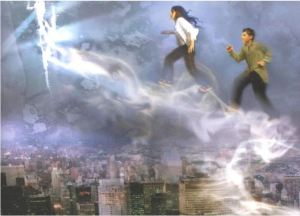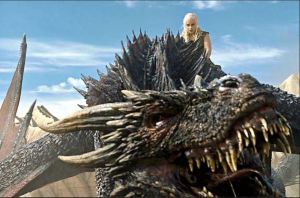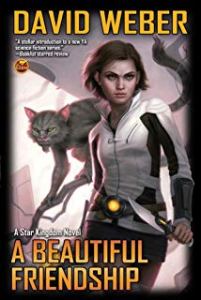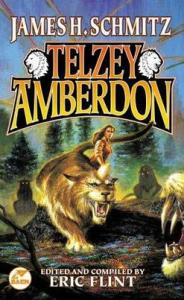Sorry about the delay between posts—I’ve been under the weather lately.
I was recently reading a new “Sharing Knife” story by Lois McMaster Bujold, and it suddenly occurred to me that the relationship of Bujold’s Lakewalkers to Farmers is exactly that of Anne McCaffrey’s Dragonriders to Holders.
But let me back up a bit.
The Sharing Knife
 The world of Bujold’s Sharing Knife series is a difficult and dangerous one. Most people live in a basically agrarian culture, a sort of cross between the traditional medieval fantasy world and the Wild West. They fear the enigmatic “Lakewalkers,” men and women who wander about the countryside in “patrol” groups and are rumored to have magical powers. The Lakewalkers claim to be searching for what ordinary people call “blight bogles,” but some consider these to be a mere myth.
The world of Bujold’s Sharing Knife series is a difficult and dangerous one. Most people live in a basically agrarian culture, a sort of cross between the traditional medieval fantasy world and the Wild West. They fear the enigmatic “Lakewalkers,” men and women who wander about the countryside in “patrol” groups and are rumored to have magical powers. The Lakewalkers claim to be searching for what ordinary people call “blight bogles,” but some consider these to be a mere myth.
They’re not a myth, of course. In reality the Lakewalkers, who have the ability to use a kind of magic they call “groundwork” (an extremely interesting and well-developed idea in itself), are constantly on the watch to destroy “malices” as they arise. These malices are truly nasty beings that can mentally enthrall normal humans and mutate animals into humanoid minions. If the Lakewalkers weren’t killing them off (via the grim “sharing knife” methd of the title), the malices would overrun the whole world.
Many Lakewalkers tend to look down on the people they are defending, whom they refer to generally as “farmers.” Much of the interest of the story has to do with the prickly relationship between these two interdependent groups, explored through the romance between a farm girl, Fawn, and a Lakewalker patroller, Dag.
The Dragonriders of Pern
As I mentioned in an earlier post, Anne McCaffrey’s Dragonriders of Pern is a science fiction series that reads like fantasy. The planet Pern is protected by men and women riding flying dragons. The dragons breathe fire to destroy an alien organic “Thread” that falls from the sky and, if allowed to spread, would multiply to consume the planet. To qualify as a full-fledged dragonrider, one must have the potential for a certain kind of telepathy that allows rider and dragon to bond at the dragons’ birth.
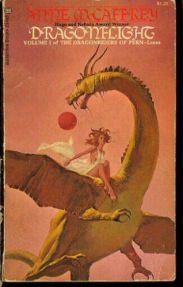 One of the things that makes the Pern stories sound like fantasy is the quasi-medieval political structure. A “Lord Holder” resembles a feudal monarch ruling over a sizable population of farmer/serfs, crafters, and minor nobility. But here the dragonriders form a separate hierarchy. The riders’ internal pecking order is a combination of aristocracy and meritocracy: the rider of the senior gold (female) dragon is a kind of queen; the rider whose bronze dragon mates with the gold becomes leader of the entire group that constitutes a Weyr; and those who lack the telepathic talent are servitors (at the lowest level, “drudges”).
One of the things that makes the Pern stories sound like fantasy is the quasi-medieval political structure. A “Lord Holder” resembles a feudal monarch ruling over a sizable population of farmer/serfs, crafters, and minor nobility. But here the dragonriders form a separate hierarchy. The riders’ internal pecking order is a combination of aristocracy and meritocracy: the rider of the senior gold (female) dragon is a kind of queen; the rider whose bronze dragon mates with the gold becomes leader of the entire group that constitutes a Weyr; and those who lack the telepathic talent are servitors (at the lowest level, “drudges”).
While the depiction of Pernese society mellowed a good bit over the course of the series—both holders and riders were pretty high-handed and violent at the beginning, less so later—one consistent theme is the uneasy relationship between the dragonriders and the common folk. Everyone knows (though they may forget in the generations between periodic Thread attacks) that the riders are essential to preserve the planet: “Worlds are lost or worlds are saved / From those dangers dragon-braved.” But the holders often resent the taxes imposed to support the Weyrs and the “searches” in which the dragonriders carry off likely young people to see if they can “impress” a dragon. Managing this tension consumes a good deal of the main characters’ time in the early books.
The Protectors and the Protected
Now I can make clear the analogy I noticed. In each case we have a relatively small society of people set apart from ordinary folks, in a good cause: they are dedicated to protecting the larger population. The select group of protectors are genuine heroes who possess special talents that fit them for the role. But the protectors are not stainless; they can abuse their powers. And the grateful population they defend aren’t always grateful; they may resent the special powers and privileges of the defenders, even aside from the possible abuse of those advantages.
It seems to be a fruitful trope for storytelling.
Rangers and Protectors
 We can find a similar structure, though not so dominant, back in The Lord of the Rings. You’ll recall that Strider—Aragorn—is one of a mysterious group of wanderers who travel the countryside, the Dúnedain or Rangers. They are regarded with suspicion by the ordinary folks in Bree; Barliman Butterbur the innkeeper warns Frodo about the suspicious-looking stranger sitting in the corner. Yet all the time the Rangers are patrolling the borders of the peaceful lands of Bree and the Shire, fending off possible threats. Aragorn says at the Council of Elrond:
We can find a similar structure, though not so dominant, back in The Lord of the Rings. You’ll recall that Strider—Aragorn—is one of a mysterious group of wanderers who travel the countryside, the Dúnedain or Rangers. They are regarded with suspicion by the ordinary folks in Bree; Barliman Butterbur the innkeeper warns Frodo about the suspicious-looking stranger sitting in the corner. Yet all the time the Rangers are patrolling the borders of the peaceful lands of Bree and the Shire, fending off possible threats. Aragorn says at the Council of Elrond:
‘Strider’ I am to one fat man who lives within a day’s march of foes that would freeze his heart, or lay his little town in ruin, if he were not guarded ceaselessly. Yet we would not have it otherwise. If simple folk are free from care and fear, simple they will be, and we must be secret to keep them so. (Fellowship of the Ring, II.2, p. 261)
Aragorn’s fond, if slightly aggrieved, remark brings out a difference. Pern’s dragonriders are a public society of defenders; everyone knows of their special role. But Tolkien’s Dúnedain, like the Lakewalkers in Bujold’s more recent fantasy, play a less public role. They are set apart, but because their heroism is unrecognized, they are objects more of suspicion than of admiration.
For a more science-fictional take, consider Larry Niven’s Protectors, which figure in the novel Protector (naturally) and in the Ringworld stories. Niven imagines that humanity is descended from a species called the Pak, which matures through three life stages: child, breeder, and protector. The transition from the not-very-bright breeder stage to the highly intelligent and formidable protector stage is triggered by eating a root the characters call “tree-of-life.” When a Pak colony arrived on Earth ages ago, however, the soil lacked a chemical necessary for the tree-of-life root to function. The “breeders” could not change into protectors; instead, they evolved on their own into modern-day humans. Niven’s intriguing conceit is what we see as symptoms of old age actually represent the incomplete transition to the gaunt, tough, hairless protector stage.
Niven depicts the protectors as genetically compelled to protect the members of their own family or clan—the ones who “smell right.” A functioning Pak colony wouldn’t be as much like a human society as on Pern or Middle-Earth or Bujold’s imaginary world: it would consist of carefree, barely-sentient breeders watched over by creatures ruthlessly dedicated to their preservation. Think of it as an extreme case of the separation of defenders from defended.
Counter-Examples
On the other hand, a number of stories depict defenders who are much more thoroughly integrated into their broader societies.
In Diane Duane’s Young Wizards series, youngsters with the potential for wizardry are called, not by receiving a letter from Hogwarts, but in more obscure ways—for example, running across a library book called So You Want To Be A Wizard. There are more wizards around than one might think, because on our planet they don’t advertise their powers: young wizards still go to school, grown-up wizards might be writers or sell advertising. (And not all of them are human; there are some very entertaining books about feline wizards.) But all of them are dedicated to the preservation and fostering of Life, by way of the Wizard’s Oath each must take. In this setup, there’s no resentment of the society of protectors because no one knows they exist; and abuse of wizardly powers is almost unheard-of, since violating the Oath tends to result in forgetting that wizardry even exists.
By contrast, the elite corps of Lensmen in E.E. Smith’s famous series are publicly known and highly respected. They play the role of galactic policemen and secret agents, with particular attention to the mysterious pirates and drug-runners called “Boskone.” Like the Young Wizards, the Lensmen are (conveniently) incorruptible, being screened at the outset by the equally mysterious but benevolent Arisians. (This whole business of incorruptibility is something we need to examine more closely on another occasion.) But they don’t mind mixing in ordinary society—Gray Lensman includes a scene set at a formal ball—although their grave responsibilities often make them feel set apart in their lonely dedication.
Superheroes, as a class, may occupy the same position. They live as part of the general public, though their identities are usually secret. They tend to act as individuals rather than as a whole society, though they do come in small groups (and may occasionally take part in mega-battles that engage the whole range of heroes). But the modern superhero does show the ambivalence that often characterizes the select defender (Mr. Incredible’s remark that he sometimes wishes the world would just stay saved for a while). And some graphic novels take up the question of what it’s like for the ordinary person to live in a world full of superheroes—notably Kurt Busiek’s thoughtful Marvels (1994).
Narrative Tensions
The select society of protectors is a fine place for heroes. But it’s also dangerous. What if the protectors aren’t incorruptible, and turn bad? What if they become contemptuous of the people they protect, and come to think of themselves as better than the “rabble”? In many of the scenarios above, it takes special talents to qualify as one of the defenders. How likely is it that those who see themselves as specially qualified will end up thinking of themselves as superior? These questions form fertile ground for various plotlines.
The notion of the select (if not superior) set of defenders may even be seen as applying to a military organization, whose purpose is to protect the general public. “Citizen soldiers,” or draftees, may see themselves as primarily part of the overall society, temporarily detailed to do their civic duty; but a professional military, which can form its own tightly-knit society with its families and dependents, may be more easily tempted to think of itself as a group apart, with its own loyalties and camaraderie. In fiction, the entire genre of military SF borders the trope we’re examining here. In real life, the American military, at least, seems to have avoided that trap; we have not yet seen anything like a military coup.
Everyone Is a Tuvela
It’s interesting to contemplate the opposite trope: the citizen soldier model taken to its limit.
 In James Schmitz’s 1968 novel The Demon Breed, a biochemist named Nile Etland on the human colony world Nandy-Cline discovers that independent researcher Ticos Cay has been captured by cruel and formidable aliens called the Parahuans. Ticos has played on the Parahuans’ own near-superstitious fears to convince them that Nile is a Tuvela, a member of a secret society of superhumans that are the real rulers of human civilization. All Nile has to do is convince the invaders that she is, in fact, a superior being it would be death to tangle with. And, with the help of Ticos, two mutant otters, and her own encyclopedic knowledge of the unique biology of Nandy-Cline, she does a marvelous job of pulling the wool over the Parahuans’ eyes and sending them fleeing back to their own worlds.
In James Schmitz’s 1968 novel The Demon Breed, a biochemist named Nile Etland on the human colony world Nandy-Cline discovers that independent researcher Ticos Cay has been captured by cruel and formidable aliens called the Parahuans. Ticos has played on the Parahuans’ own near-superstitious fears to convince them that Nile is a Tuvela, a member of a secret society of superhumans that are the real rulers of human civilization. All Nile has to do is convince the invaders that she is, in fact, a superior being it would be death to tangle with. And, with the help of Ticos, two mutant otters, and her own encyclopedic knowledge of the unique biology of Nandy-Cline, she does a marvelous job of pulling the wool over the Parahuans’ eyes and sending them fleeing back to their own worlds.
But there are no Tuvelas. Nile is a brilliantly resourceful and competent woman, but she’s not superhuman. Neither is Ticos, nor any of the other inhabitants who are involved at the end in dispersing the Parahuans. They’re simply ordinary humans. And there is no secret organization. Rather, Schmitz’s hypothesis is that a significant fraction of ordinary people (Ticos calls them “antipredators”) can take on that defensive role when extraordinary circumstances require them to do so. As one character remarks, the Parahuans would have run into “Tuvela” behavior no matter where they sought to attack.
The title The Demon Breed doesn’t refer to the Parahuans. It refers, from the unfortunate Parahuans’ point of view, to the uncannily resilient humans. Like the sturdy hobbits of the Shire, human beings are capable of rising to the occasion. At the end of the story, when the local Nandy-Cline military forces have mobilized to make sure the fleeing Parahuans don’t escape, Nile reflects: “The human demon was awake and snarling on Nandy-Cline” (ch. 9).
The select society of defenders is a potent storytelling trope; but so is the distributed resourcefulness of the ordinary person. And both may be useful to keep in mind as we act where we are needed.

